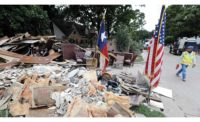As wildfires continued to blaze their way across the West—killing at least 35 people and causing up to $150 billion in damage—construction on some sites was unable to continue as the air quality index crept higher and higher.
Cal Fire said Sept. 15 that 25 deaths were attributable to the fires in California and that more than 4,200 structures had been destroyed. Wildfires have burned more than 3.2 million acres since the fires started Aug. 15. “With no significant precipitation in sight, California remains dry and ripe for wildfires,” the agency said.
In Washington and Oregon, officials have linked at least 10 deaths to the wildfires, but dozens are still missing with some areas inaccessible for assessment.
“This could be the greatest loss in human lives and property due to wildfire in our state’s history,” said Oregon Gov. Kate Brown (D).
Poor air quality has led contractors throughout the region to pause work on projects. “The California wildfires have resulted in unhealthy air quality and extreme heat, creating heightened hazards for AGC of California contractors,” says Peter Tateishi, CEO, AGC of California.
Balfour Beatty halted some West Coast operations on project sites in impacted areas until air quality conditions improve, a firm spokesperson told ENR in a statement.
“We made the decision to temporarily suspend work on six projects over the past two weeks in order to protect our craftspeople, professional staff and our trade partners,” says Mike Popp, vice president of corporate safety and insurance at XL Construction, which has projects in the Bay Area and Sacramento, Calif.
Stantec has postponed some projects, but because much of the firm’s work is considered “critical infrastructure,” that work has continued through COVID-19 restrictions and now wildfires, says Michelle Cross, a senior principal in Stantec’s Sacramento office and a leader in its environmental services group.
Dennis Barlow, director of safety services for the Oregon Columbia Chapter of the AGC, says, “Contractors have had to limit or even cease outdoor work in most of these areas in order to protect their workers from potential respiratory issues related to the smoke.”
Smaller fires in Oregon and Washington on Sept. 7 quickly grew over the week, fanned by high winds coupled with low humidity. More than 1.6 million acres across the two states have been lost to flames across roughly three dozen large fires burning at the peak. Officials say most of the new fires were human-caused, which includes fires sparked by power lines damaged from fallen trees.
In Oregon, hundreds of homes and commercial buildings were lost outside of Medford, near the southern border with California, where the Almeda Drive Fire devastated the towns of Phoenix and Talent. A man was arrested for allegedly starting a fire that merged with the Almeda fire. The Beachie Creek Fire, currently at 190,137 acres and 15% containment, killed at least four people and destroyed large portions of several towns in the Santiam Valley east of Salem. In Washington, the small town of Malden, about 30 miles south of Spokane, was about 80% destroyed.
AccuWeather founder and CEO Dr. Joel N. Myers said his company estimated that damage to infrastructure, homes and businesses, coupled with economic losses, will result in the country facing economic losses of between $130 billion and $150 billion.
Prevention
To prevent further wildfire damage, Pacific Gas and Electric Co. in California has been turning off power to counties as high winds approached the fire-prone areas, as part of the state’s fire mitigation efforts. Downed power lines caused major fires in the 2017-18 wildfire season, including the deadly 2018 Camp Fire that blazed through Paradise, Calif., killing 85 people and destroying 14,000 structures in the town.
PG&E made a number changes after filing for bankruptcy and incurring more than $2 billion in fines due to those fires. “Over the past few years, high temperatures, extreme dryness and record-high winds have increased fire risks across the areas we serve in northern and central California,” says PG&E spokesman Jeff Smith. Nearly one-third of its electric lines are now in high fire-threat areas.
Last February, Southern California Edison filed its 2020-22 wildfire mitigation plan with the California Public Utilities Commission, a $3.8-billion multiyear effort that aims to reduce risk of fire ignitions caused by the utility.
The company’s 2020 plan proposes to install at least 700 circuit miles of covered conductor, reducing ignitions caused by objects that contact distribution power lines, and add fast-acting fuses to help interrupt electric current more quickly to reduce the risk of ignitions. SCE also is piloting new predictive technologies that will warn of potential equipment failures and allow for proactive responses.
The power shutoffs were necessary but caused other issues in Paradise, says Public Works Director Marc Mattox, an ENR 2020 Newsmaker for his work during the Camp Fire.
With the power out, traffic lights couldn’t function, hampering traffic through town, he says. It was also difficult to get information to residents without cellphones as the Bear Fire raged just about 20 miles away, Mattox says.
The town has never been under threat from the current fire, but because officials couldn’t communicate directly to all residents, rumors led people to believe there was an imminent fire threat, Mattox says, and many people evacuated from Paradise during the height of the Bear Fire. “Obviously, the entire community was triggered and was very cautious,” he adds.
Within the next month, Paradise is slated to receive generators to run the traffic lights in the event of a future power shutoff. “Hopefully we won’t have one for the rest of the year,” he says. “But I don’t think that’s likely.”
The town has also hired a consultant to help analyze the development of a physical warning system throughout town, such as sirens, to warn residents of wildfire threats.
The small town—to which only about 4,000 of its pre-Camp Fire 26,000 residents have returned—can be a model for other towns up and down the West Coast that will need to recover after this wildfire season, Mattox says.
Paradise, which before the fire, spent between $5 million and $6 million a year for capital improvements, now has about $121 million of capital and disaster recovery projects lined up.
“We’re thankful for all of the recovery funding,” he says. But going forward, he adds, there needs to be more emphasis on prevention. “At times it looks like there isn’t any hope,” he says. “But there is reason to be hopeful.”
By Greg Aragon, Erica Berardi, Tim Newcomb, Pam Radtke Russell and Scott Blair











